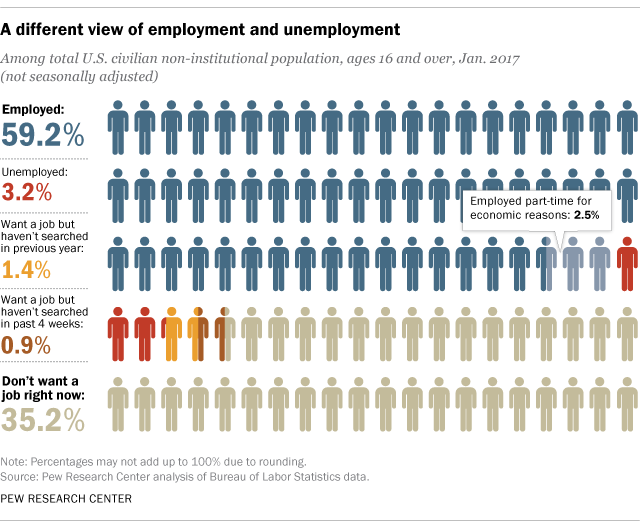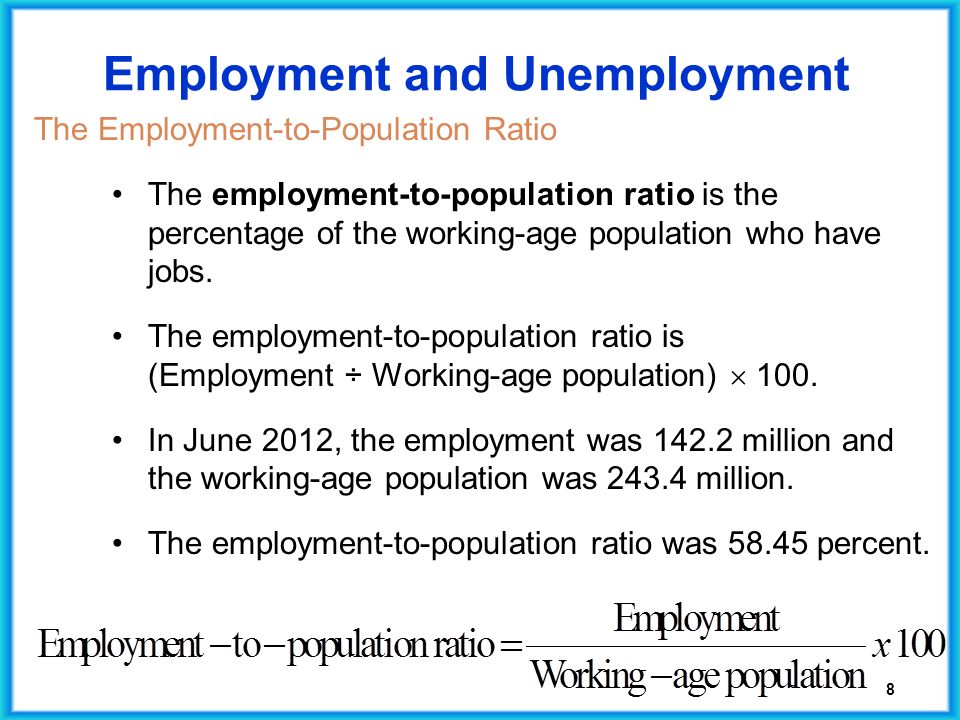What Does Employment To Population Ratio Mean
The Labor Force Participation Rate is calculated by dividing the Labor Force by the total adult population that is at least 16 years of age and multiplying the results by 100 to yield the percentage. The employment-population ratio depends first on the percentage of the population that is in the labor force that is either working or actively looking for work and second on the percentage.
:max_bytes(150000):strip_icc()/thinkstockphotos_493208894-5bfc2b9746e0fb0051bde2b8.jpg) Employment To Population Ratio Definition
Employment To Population Ratio Definition
Unlike the Unemployment Rate this accounts for those who have stopped looking for work.

What does employment to population ratio mean. The US Employment Population Ratio or Employment to Population Ratio is the percentage of the US working-age population age 16 that is employed. Employment to population ratio 15 total modeled ILO estimate from The World Bank. In other words it is the percentage of the population that is either working or actively seeking work.
US Bureau of Labor Statistics here. The Bureau of Labor Statistics BLS defines the employment-population ratio as the ratio of total civilian employment to the civilian noninstitutional population. It therefore captures adults who were discouraged.
EPR Persons employed x 100 Working-age population Recommended sources Labour force surveys are typically the preferred source of information for determining the employment- to-population ratio. The employment-to-population ratio is equal to the number of persons employed divided by the working-age population and multiplied by 100. Theres also the employment-population ratio which measures employed people as a percentage of the 16-and-over civilian non-institutional population.
The employment-to-population ratio is a measure of the number of people employed against the total working-age population. In other words it is the percentage of the population that is currently working. The employment rate as defined by OECD is the employment-to-population ratio the number of people of working age in the population who are employed.
Employment rates are sensitive to the economic cycle but in the longer term they are significantly affected by governments higher education and income support. According to the International Labour Organization people are considered employed if theyve had an hour or more in gainful employment in the most recent week. Employed ч Civilian Noninstitutional Population x 100.
The employment- to-population ratio is calculated as follows. 1 Simply put it is the portion of the adult population 16 years and older that is employed. The employment-population ratio represents the number of employed people as a percentage of the civilian noninstitutional population.
In other words it is the percentage of the population that is currently working. They are calculated as the ratio of the employed to the working age population. The employment-population ratio is calculated as.
The ratio of employed persons to the total civilian noninstitutionalized population 16 years old or older. Employment rates are defined as a measure of the extent to which available labour resources people available to work are being used. The employment-population ratio for example measures the share of employment among the entire adult population not just those looking for work.
The employment-to-population ratio is defined as the proportion of a countrys working-age population that is employed. Though the ratio has some quirks its less affected by seasonal variations or short-term fluctuations in labor-market behavior than the unemployment rate. Such surveys can be designed to cover virtually the entire non-.
This measure is the number of employed as a percentage of the civilian noninstitutional population 16 years old and over. Also termed the employment rate the employment-population ratio is used as an alternative to the unemployment rate. The employment-population ratio measures the ratio of adults 16 years of age and older who are employed.
The employment-population ratio is less prone to vagaries caused by seasonal workers or by. The unemployment rate is calculated by dividing the number of people employed by the labor force then multiplying by 100 to derive the percentage. Seasonal variations and short-term labor fluctuations do not affect the.
:max_bytes(150000):strip_icc()/unemployment-5bfc344bc9e77c00519c4b43.jpg) Employment To Population Ratio Definition
Employment To Population Ratio Definition
 Forget The Unemployment Rate Here S The Chart To Focus On On Jobs Day Chart Numbers Show Find A Job
Forget The Unemployment Rate Here S The Chart To Focus On On Jobs Day Chart Numbers Show Find A Job
 Employment Population Ratio Formula
Employment Population Ratio Formula
:max_bytes(150000):strip_icc()/GettyImages-172752359-82d9bd91a55f492e9bb9cd35c5e71358.jpg) Employment To Population Ratio Definition
Employment To Population Ratio Definition
 The Us Employment Population Ratio Rose Even As The Labour Participation Rate Fell In February Mortgage Pay Off Mortgage Early Employment
The Us Employment Population Ratio Rose Even As The Labour Participation Rate Fell In February Mortgage Pay Off Mortgage Early Employment
 Employment Population Ratio Formula
Employment Population Ratio Formula
 Employment Population Ratio 25 54 Yrs Lns12300060 Fred St Louis Fed
Employment Population Ratio 25 54 Yrs Lns12300060 Fred St Louis Fed
 The Us Employment Population Ratio Is Back Where It Used To Be In 1984 Stock Broker Employment Investors
The Us Employment Population Ratio Is Back Where It Used To Be In 1984 Stock Broker Employment Investors
 The Us Employment To Population Ratio Employment Economics Ratio
The Us Employment To Population Ratio Employment Economics Ratio
 Going Beyond The Unemployment Rate Pew Research Center
Going Beyond The Unemployment Rate Pew Research Center
/GettyImages-1025082012-5ba64f7f4911481bb11a2e2137be6c37.jpg) Employment To Population Ratio Definition
Employment To Population Ratio Definition
 Employment Population Ratio Formula
Employment Population Ratio Formula
 Employment Population Ratio Formula
Employment Population Ratio Formula
:max_bytes(150000):strip_icc()/profile-EricEstevez-4439ff1611f74bbfbabfc9fa32af2072.jpg) Employment To Population Ratio Definition
Employment To Population Ratio Definition
 Employment To Population Ratio Overview Formula Global Data
Employment To Population Ratio Overview Formula Global Data
 This Is Why Doesn T Qe Work Graph Of Velocity Of Money Stock Fed Usd Macro Velocity Money Study Hard
This Is Why Doesn T Qe Work Graph Of Velocity Of Money Stock Fed Usd Macro Velocity Money Study Hard
 Median Household Income Forecast Median Household Income Household Income Income
Median Household Income Forecast Median Household Income Household Income Income
 Employment Population Ratio Formula
Employment Population Ratio Formula

Post a Comment for "What Does Employment To Population Ratio Mean"